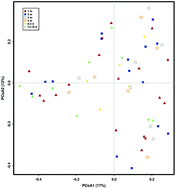Association between sn-2 fatty acid profiles of breast milk and development of the infant intestinal microbiome†
Abstract
Increasing evidence shows that host diet and gut microbes are related. Previous studies have shown the effects of specific dietary fatty acids (FAs) on intestinal microbiota, but little is known about the effect of the stereospecifically numbered sn-2 position in triglycerides (TG) of human milk on the gut microbiome of infants. This study aimed at examining possible effects of sn-2 FAs of human milk on the gut microbial development of breastfeeding babies. Sn-2 FAs and intestinal microbiota were assessed by GC-MS and high-throughput 16S rRNA sequencing, respectively. The results showed that breast milk from mothers in China contained ten major sn-2 FAs dominated by palmitic acid (C16:0, 54.42%), oleic acid (C18:1 n-9, 14.95%), linoleic acid (LA, C18:2 n-6, 12.81%), myristic acid (C14:0, 4.50%) and C12:0 (3.17%). Total long chain unsaturated fatty acids (LCUFA) decreased from colostrum to mature milk, while total saturated fatty acids (SFA) showed no significant difference during lactation. A significant association between sn-2 FAs in milk and infant gut microbiota was found between decanoic acid (C10:0), myristic acid (C14:0), stearic acid (C18:0), C16:0, arachidonic acid (AA, C20:4 n-6), docosahexaenoic acid (DHA, C22:6 n-3) with Bacteroides, Enterobacteriaceae, Veillonella, Streptococcus, and Clostridium. These microbes were involved in short-chain fatty acid (SCFA) production and other functions, and significantly increased at 13–15 d after breastfeeding was initiated. C16:0 and DHA were relevant to most of the microbes. This study demonstrated the relatively steady profiles of sn-2 FAs in breast milk and gut microbiota of infants, together with their correlation during the breastfeeding period. The above results provided important information for designing the configuration of FAs in next-generation formulas for Chinese infants.



 Please wait while we load your content...
Please wait while we load your content...